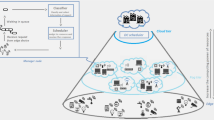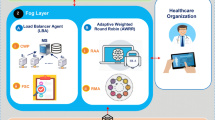Abstract
Fog computing is a developing paradigm for bringing cloud computing capabilities closer to end-users. Fog computing plays an important role in improving resource utilization and decreasing delay for internet of things (IoT) applications. At the same time, it faces many challenges, including challenges related to energy consumption, scheduling and resource overload. Load balancing helps to reduce delay, increase user satisfaction, and also increase system efficiency by efficiently and fairly allocation of tasks among computing resources. Fair load distribution among fog nodes is a difficult challenge due to the increasing number of IoT devices. In this research, we suggested a new approach for fair load distribution in fog environment. The Q-learning algorithm-based load balancing method is executed as the proposed approach in the fog layer. The objective of this method is to simultaneously improve the load balancing and delay. In this technique, the fog node uses reinforcement learning to choose whether to handle a task it receives via IoT devices directly, or whether to send it to a nearby fog node or the cloud. The simulation findings demonstrate that our approach results a suitable technique for fair load distribution among fog nodes, which improves the delay, run time, network utilization, and standard deviation of load on nodes than other compared techniques. In this way, in the case where the number of fog nodes is considered to be 4, the delay in the proposed method is reduced by around 8.44% in comparison to the load balancing and optimization strategy (LBOS) method, 26.65% in comparison to the secure authentication and load balancing (SALB) method, 29.15% in comparison to the proportional method, 7.75% in comparison to the fog cluster-based load-balancing (FCBLB) method, and 36.22% in comparison to the random method. In the case where the number of fog nodes is considered to be 10, the delay in the proposed method is reduced by around 13.80% in comparison to the LBOS method, 29.84% in comparison to the SALB method, 32.23% in comparison to the proportional method, 13.34% in comparison to the FCBLB method, and 39.1% in comparison to the Random method.












Similar content being viewed by others
Data availability
The datasets generated during and/or analysed during the current study are available from the corresponding author on reasonable request.
Notes
Quality of Experience.
Quality of Service.
Electro Encephalo Gram.
Load Balancing and Optimization Strategy.
Secure Authentication and Load Balancing.
Fog Cluster-Based Load-Balancing.
References
Martinez, I., Hafid, A. S., & Jarray, A. (2021). Design, resource management, and evaluation of fog computing systems: a survey. IEEE Internet of Things Journal, 8(4), 2494–2516.
Yousefpour, A., Fung, C., Nguyen, T., Kadiyala, K., Jalali, F., Niakanlahiji, A., Kong, J., & Jue, J. P. (2019). All one needs to know about fog computing and related edge computing paradigms: A complete survey. Journal of Systems Architecture, 98, 289–330.
Kashani, M. H., & Mahdipour, E. (2023). Load balancing algorithms in fog computing. IEEE Transactions on Services Computing, 16, 1505–1521.
Kashyap, V., & Kumar, A. (2022). Load balancing techniques for fog computing environment: Comparison, taxonomy, open issues, and challenges. Concurrency and Computation: Practice and Experience, 34(23), e7183.
Jamil, B., Ijaz, H., Shojafar, M., Munir, K., & Buyya, R. (2022). Resource allocation and task scheduling in fog computing and internet of everything environments: a taxonomy, review, and future directions. ACM Computing Surveys, 54, 1–38. https://doi.org/10.1145/3513002
Batra, S., Anand, D., & Singh, A. (2022). A brief overview of load balancing techniques in fog computing environment. In 2022 6th international conference on trends in electronics and informatics (ICOEI). IEEE (pp. 886–891).
Hamid, L., Jadoon, A., & Asghar, H. (2022). Comparative analysis of task level heuristic scheduling algorithms in cloud computing. The Journal of Supercomputing, 78, 12931–12949.
Chowdhury, S., & Katangur, A. (2022). Threshold based load balancing algorithm in cloud computing. In 2022 IEEE international conference on joint cloud computing (JCC). IEEE (pp. 23–28).
Katangur, A., Akkaladevi, S., & Vivekanandhan, S. (2022). Priority weighted round robin algorithm for load balancing in the cloud. In 2022 IEEE 7th international conference on smart cloud (SmartCloud). IEEE (pp. 230–235).
Al-Amodi, S., Patra, S. S., Bhattacharya, S., Mohanty, J. R., Kumar, V., & Barik, R. K. (2022). Meta-heuristic algorithm for energy-efficient task scheduling in fog computing. Recent trends in electronics and communication (pp. 915–925). Springer.
AlShathri, S. I., Chelloug, S. A., & Hassan, D. S. (2022). Parallel meta-heuristics for solving dynamic offloading in fog computing. Mathematics, 10(8), 1258.
He, J. (2022). Cloud computing load balancing mechanism taking into account load balancing ant colony optimization algorithm. Computational Intelligence and Neuroscience. https://doi.org/10.1155/2022/3120883
Ijeoma, C. C., Inyiama, P., Samuel, A., Okechukwu, O. M., & Chinedu, A. D. (2022). Review of hybrid load balancing algorithms in cloud computing environment. arXiv:2202.13181.
Khan, M. S. A., & Santhosh, R. (2022). Task scheduling in cloud computing using hybrid optimization algorithm. Soft Computing, 26(23), 13069–13079.
Talaat, F. M., Ali, H. A., Saraya, M. S., & Saleh, A. I. (2022). Effective scheduling algorithm for load balancing in fog environment using CNN and MPSO. Knowledge and Information Systems, 64(3), 773–797.
Gures, E., Shayea, I., Ergen, M., Azmi, M. H., & El-Saleh, A. A. (2022). Machine learning-based load balancing algorithms in future heterogeneous networks: a survey. IEEE Access, 10, 37689–37717.
Sheikhpour, R., Sarram, M. A., Gharaghani, S., & Chahooki, M. A. Z. (2017). A survey on semi-supervised feature selection methods. Pattern Recognition, 64, 141–158.
Tran-Dang, H., Bhardwaj, S., Rahim, T., Musaddiq, A., & Kim, D.-S. (2022). Reinforcement learning based resource management for fog computing environment: Literature review, challenges, and open issues. Journal of Communications and Networks, 24(1), 83–98.
Prudencio, R. F., Maximo, M. R., & Colombini, E. L. (2022). A survey on offline reinforcement learning: taxonomy, review, and open problems. arXiv:2203.01387.
Xu, Y., Xu, W., Wang, Z., Lin, J., & Cui, S. (2019). Load balancing for ultradense networks: A deep reinforcement learning-based approach. IEEE Internet of Things Journal, 6(6), 9399–9412.
Li, S. E. (2023). Deep reinforcement learning. Reinforcement learning for sequential decision and optimal control (pp. 365–402). Springer.
Wang, X., Wang, S., Liang, X., Zhao, D., Huang, J., Xin, X., Dai, B., & Miao, Q. (2022). Deep reinforcement learning: a survey. IEEE Transactions on Neural Networks and Learning Systems. https://doi.org/10.1109/TNNLS.2022.3207346
Singh, J., Singh, P., Amhoud, E. M., & Hedabou, M. (2022). Energy-efficient and secure load balancing technique for SDN-enabled fog computing. Sustainability, 14(19), 12951.
Phan, L. A., Nguyen, D. T., Lee, M., Park, D. H., & Kim, T. (2021). Dynamic fog-to-fog offloading in SDN-based fog computing systems. Future Generation Computer Systems, 117, 486–497.
Belkout, N. E., Zeraoulia, K., Shahzad, M. N., Liu, L., & Yuan, B. (2022). A load balancing and routing strategy in fog computing using deep reinforcement learning. In 2022 international conference on electrical, computer and energy technologies (ICECET). IEEE (pp. 1–8).
Singh, P., Kaur, R., Rashid, J., Juneja, S., Dhiman, G., Kim, J., & Ouaissa, M. (2022). A fog-cluster based load-balancing technique. Sustainability, 14(13), 7961.
Nair, B., & Bhanu, S. (2022). A reinforcement learning algorithm for rescheduling preempted tasks in fog nodes. Journal of Scheduling, 25, 547–565.
Baek, J., & Kaddoum, G. (2021). Heterogeneous task offloading and resource allocations via deep recurrent reinforcement learning in partial observable multifog networks. IEEE Internet of Things Journal, 8(2), 1041–1056.
Divya, V., & Sri, R. L. (2019). ReTra: reinforcement based traffic load balancer in fog based network. In 2019 10th international conference on computing, communication and networking technologies (ICCCNT), 2019.
Talaat, F. M., Saraya, M. S., Saleh, A. I., Ali, H. A., & Ali, S. H. (2020). A load balancing and optimization strategy (LBOS) using reinforcement learning in fog computing environment. Journal of Ambient Intelligence and Humanized Computing, 11(11), 4951–4966.
Kadhim, A. J., & Naser, J. I. (2021). Proactive load balancing mechanism for fog computing supported by parked vehicles in IoV-SDN. China Communications, 18(2), 271–289.
Sharma, S., & Saini, H. (2019). A novel four-tier architecture for delay aware scheduling and load balancing in fog environment. Sustainable Computing: Informatics and Systems, 24, 100355.
Xu, X., Fu, S., Cai, Q., Tian, W., Liu, W., Dou, W., Sun, X., & Liu, A. X. (2018). Dynamic resource allocation for load balancing in fog environment. Wireless Communications and Mobile Computing, 2018, 6421607.
Beraldi, R., Canali, C., Lancellotti, R., & Mattia, G. P. (2020). A random walk based load balancing algorithm for fog computing. In 2020 Fifth international conference on fog and mobile edge computing (FMEC), 2020.
Manju, A. B., & Sumathy, S. (2019). Efficient load balancing algorithm for task preprocessing in fog computing environment. Smart intelligent computing and applications (pp. 291–298). Springer.
Talaat, F. M., Ali, S. H., Saleh, A. I., & Ali, H. A. (2019). Effective load balancing strategy (ELBS) for real-time fog computing environment using fuzzy and probabilistic neural networks. Journal of Network and Systems Management, 27(4), 883–929.
Pradhan, A., Bisoy, S. K., Kautish, S., Jasser, M. B., & Mohamed, A. W. (2022). Intelligent decision-making of load balancing using deep reinforcement learning and parallel PSO in cloud environment. IEEE Access, 10, 76939–76952.
Puthal, D., Ranjan, R., Nanda, A., Nanda, P., Jayaraman, P. P., & Zomaya, A. Y. (2019). Secure authentication and load balancing of distributed edge data centers. Journal of Parallel and Distributed Computing, 124, 60–69.
Tellioglu, I., & Mantar, H. A. (2009). A proportional load balancing for wireless sensor networks. In 2009 third international conference on sensor technologies and applications (pp. 514–519).
Houidi, O., Zeghlache, D., Perrier, V., Quang, P. T. A., Huin, N., Leguay, J., & Medagliani, P. (2022). Constrained deep reinforcement learning for smart load balancing. In 2022 IEEE 19th annual consumer communications & networking conference (CCNC). IEEE (pp. 207–215).
Lu, H., Gu, C., Luo, F., Ding, W., & Liu, X. (2020). Optimization of lightweight task offloading strategy for mobile edge computing based on deep reinforcement learning. Future Generation Computer Systems, 102, 847–861.
Zhu, X. k., Zhang, Q., Liu, L., Cheng, T., Yao, S., Zhou, W., & He, J. (2019). DLB: deep learning based load balancing. arXiv:1910.08494.
Alvi, A. N., Javed, M. A., Hasanat, M. H. A., Khan, M. B., Saudagar, A. K. J., Alkhathami, M., & Farooq, U. (2022). Intelligent task offloading in fog computing based vehicular networks. Applied Sciences, 12(9), 4521.
Tu, Y., Chen, H., Yan, L., & Zhou, X. (2022). Task offloading based on LSTM prediction and deep reinforcement learning for efficient edge computing in IoT. Future Internet, 14(2), 30.
Gupta, H., Dastjerdi, A. V., Ghosh, S. K., & Buyya, R. (2017). iFogSim: A toolkit for modeling and simulation of resource management techniques in the internet of things, edge and fog computing environments. Software-Practice and Experience, 47(9), 1275–1296.
Mahmud, R., & Buyya, R. (2019). Modeling and simulation of fog and edge computing environments using iFogSim toolkit. Fog and edge computing (pp. 433–465). Wiley.
Tahmasebi-Pouya, N., Sarram, M. A., & Mostafavi, S. (2022). A blind load-balancing algorithm (BLBA) for distributing tasks in fog nodes. Wireless Communications and Mobile Computing. https://doi.org/10.1155/2022/1533949
Funding
The authors declare that no funds, grants, or other support were received during the preparation of this manuscript.
Author information
Authors and Affiliations
Corresponding author
Ethics declarations
Conflict of interest
The authors have no relevant financial or non-financial interests to disclose.
Additional information
Publisher's Note
Springer Nature remains neutral with regard to jurisdictional claims in published maps and institutional affiliations.
Rights and permissions
Springer Nature or its licensor (e.g. a society or other partner) holds exclusive rights to this article under a publishing agreement with the author(s) or other rightsholder(s); author self-archiving of the accepted manuscript version of this article is solely governed by the terms of such publishing agreement and applicable law.
About this article
Cite this article
Tahmasebi-Pouya, N., Sarram, M.A. & Mostafavi, S. A reinforcement learning-based load balancing algorithm for fog computing. Telecommun Syst 84, 321–339 (2023). https://doi.org/10.1007/s11235-023-01049-7
Accepted:
Published:
Issue Date:
DOI: https://doi.org/10.1007/s11235-023-01049-7




